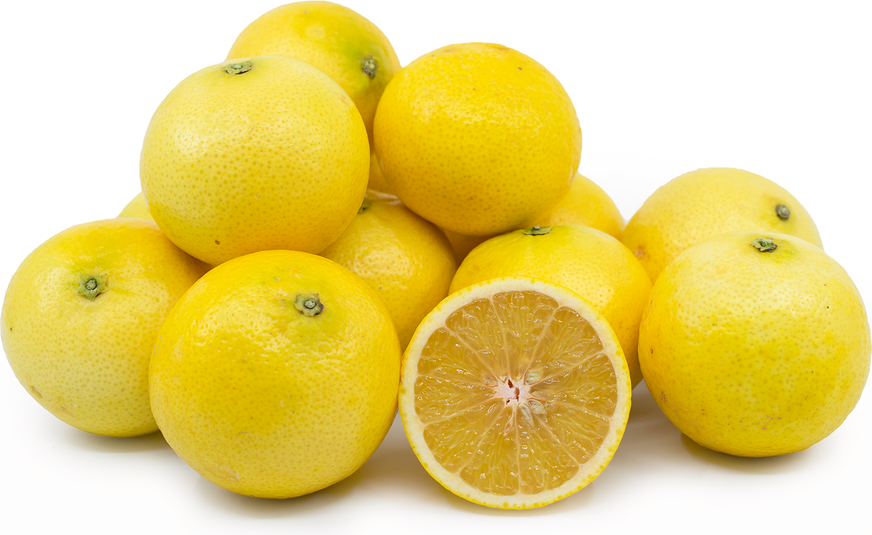


Wekiwa Tangelos
Estimated Inventory, lb : 0
Description/Taste
Wekiwa tangelos are small to medium fruits and have a spherical to ovate shape with a slightly flattened top and bottom. The peel is semi-smooth, leathery, pebbled with prominent oil glands, and delicate, easily bruised, ranging in color from bright yellow to yellow-orange. Underneath the surface, there is a moderate layer of white, spongy pith that can be easily separated from the pale yellow, golden, to amber flesh. The tender, aqueous flesh may also be blushed with pink-purple spots when grown in a warm climate and is divided into 11 to 12 segments by thin membranes, encasing many round to oval, cream-colored seeds. Wekiwa tangelos have a sweet, subtly tart, floral, and fruity flavor with low acidity, developing a less bitter and sour taste than other citrus varieties.
Seasons/Availability
Wekiwa tangelos are available for a limited season in the mid to late winter through early spring.
Current Facts
Wekiwa tangelos are botanically a part of the Citrus genus and are a rare hybrid variety belonging to the Rutaceae family. The sweet-tart fruits are similar in appearance to grapefruits, sometimes nicknamed Baby grapefruits, but the variety is generally smaller in size with a milder flavor. Wekiwa tangelos grow on trees that reach 2 to 3 meters in height and are a cross between an unknown grapefruit variety and a Sampson tangelo, which is a hybrid developed from a grapefruit and tangerine. This unusual parentage has led some growers to also nickname the variety a tangelolo, and at farmer’s markets, the fruits are sometimes known as Lavender Gem tangelos and Pink tangelos. Wekiwa tangelos are not commercially cultivated, challenging to find in local markets, and are mostly produced as a boutique or specialty citrus in limited quantities, favored for their delicate, sweet taste.
Nutritional Value
Wekiwa tangelos are an excellent source of vitamin C, an antioxidant that strengthens the immune system and are a good source of fiber to stimulate the digestive tract. The fruits also provide vitamin A to maintain healthy organ functioning, calcium to protect the development of strong bones, potassium to balance fluid levels, and magnesium to reduce symptoms associated with vision loss.
Applications
Wekiwa tangelos have a sweet and tangy flavor best suited for fresh eating and flavoring culinary dishes. The fruits can be used as a sweeter substitute in recipes calling for grapefruit, or they can be used as a flavorful replacement for oranges in fruit bowls and salads. It is important to note that the flesh may contain a significant number of seeds, requiring the fruits to be laboriously deseeded or strained if juiced. Wekiwa tangelos can be eaten straight, out-of-hand, and the fruits are easily peeled and segmented. The tangelos can also be chopped into salsas, blended into smoothies, squeezed over ceviche and other seafood, or used to flavor baked goods, ice cream, sorbet, vinaigrettes, and marinades. In addition to sauces and desserts, Wekiwa tangelo juice is popularly mixed into cocktails for a zesty, bright, and floral flavoring. Wekiwa tangelos pair well with herbs such as mint, basil, cilantro, rosemary, and parsley, fruits such as avocados, pineapples, mangos, strawberries, bananas, and coconuts, vanilla, dark chocolate, and caramel. Whole Wekiwa tangelos will keep for a couple of days at room temperature and 1 to 2 weeks when stored in the crisper drawer of the refrigerator.
Ethnic/Cultural Info
In the late 20th century, Wekiwa tangelos were promoted to chefs throughout Northern California through Bill Fujimoto, a specialty citrus expert. Fujimoto’s parents established a neighborhood store known as Monterey Market in Berkley, California, in 1961, selling packaged foods, produce, fresh meat, and dairy. In 1968, the store was changed to focus on quality produce, and over time, the market became closely associated with the California cuisine food movement. Fujimoto partnered with Chef Alice Waters and became one of the first suppliers of produce for Chez Panisse, a restaurant famous for its local and ethically sourced ingredients. As California cuisine spread throughout Northern California restaurants, chefs sought out Fujimoto as a guide to discover new and uniquely flavored citrus to incorporate into their menus. Fujimoto introduced Wekiwa tangelos to Pastry Chef Lindsey Shere at Chez Panisse, and the sweet, floral fruits were popularly incorporated into a fruity, delicate sherbet.
Geography/History
Wekiwa tangelos were believed by experts to have been developed in California sometime in the 1930s, but much of the variety’s history remains unknown. The boutique citrus was later introduced and grown in Florida in the 1980s, and in the present-day, the fruits are primarily cultivated in the Coachella Valley of Southern California. Wekiwa tangelos can be found through farmer’s markets and specialty grocers in California and Florida.
Recipe Ideas
Recipes that include Wekiwa Tangelos. One
| Bake Your Day |
|
Glazed Vanilla Bean Tangelo Quick Bread |
| Eating Well |
|
Tangelo Pork Stir-Fry |
Podcast




